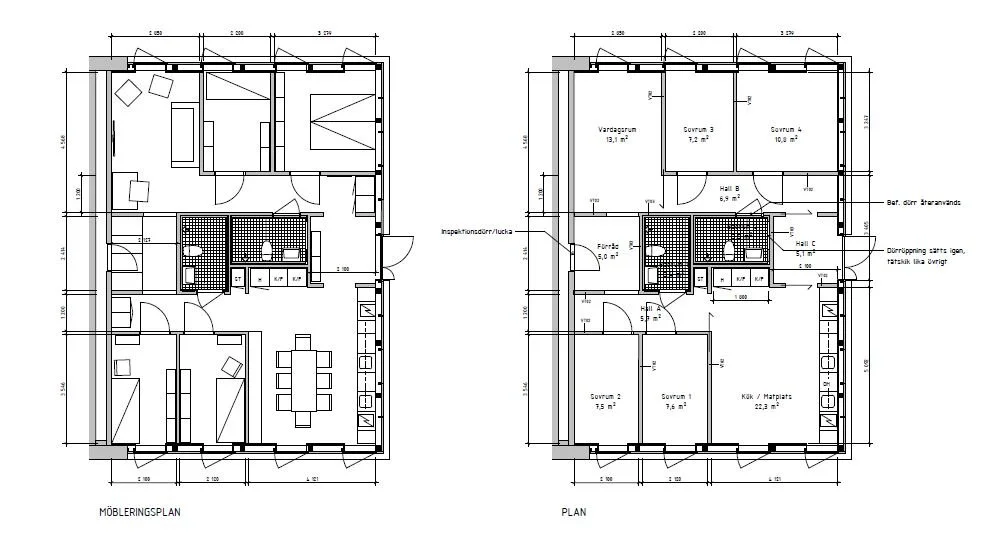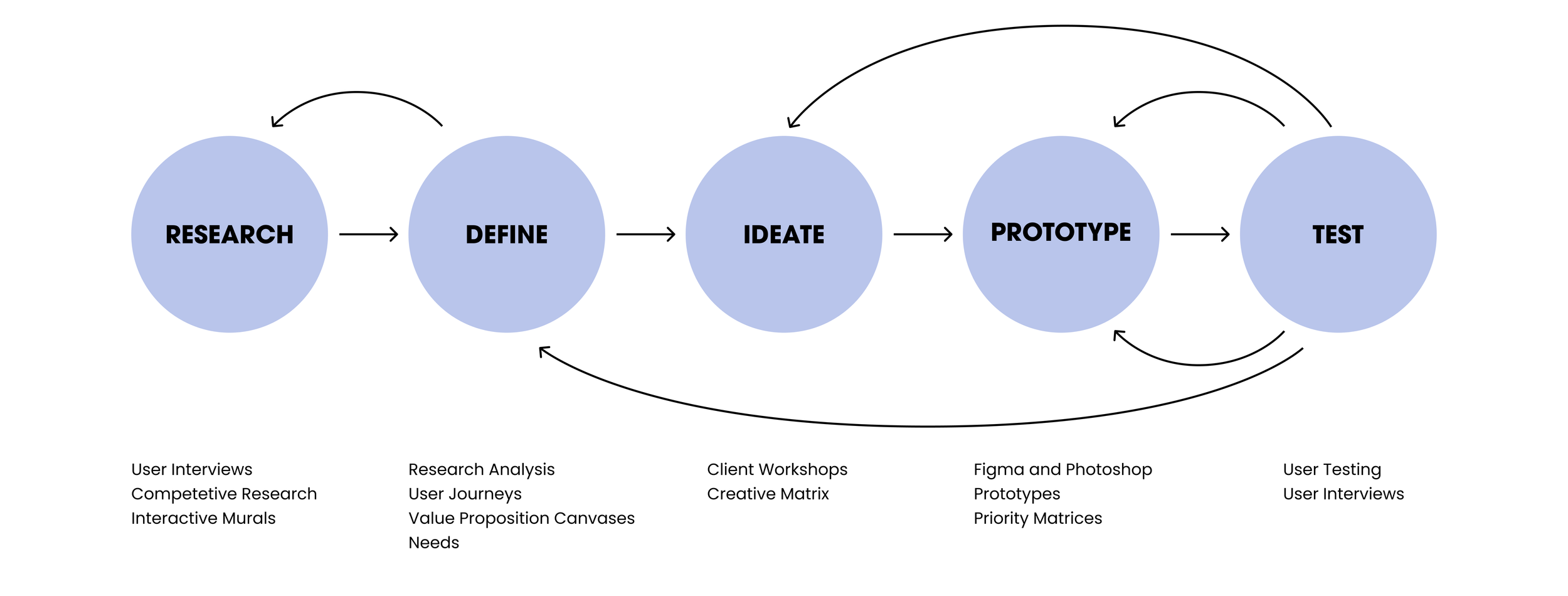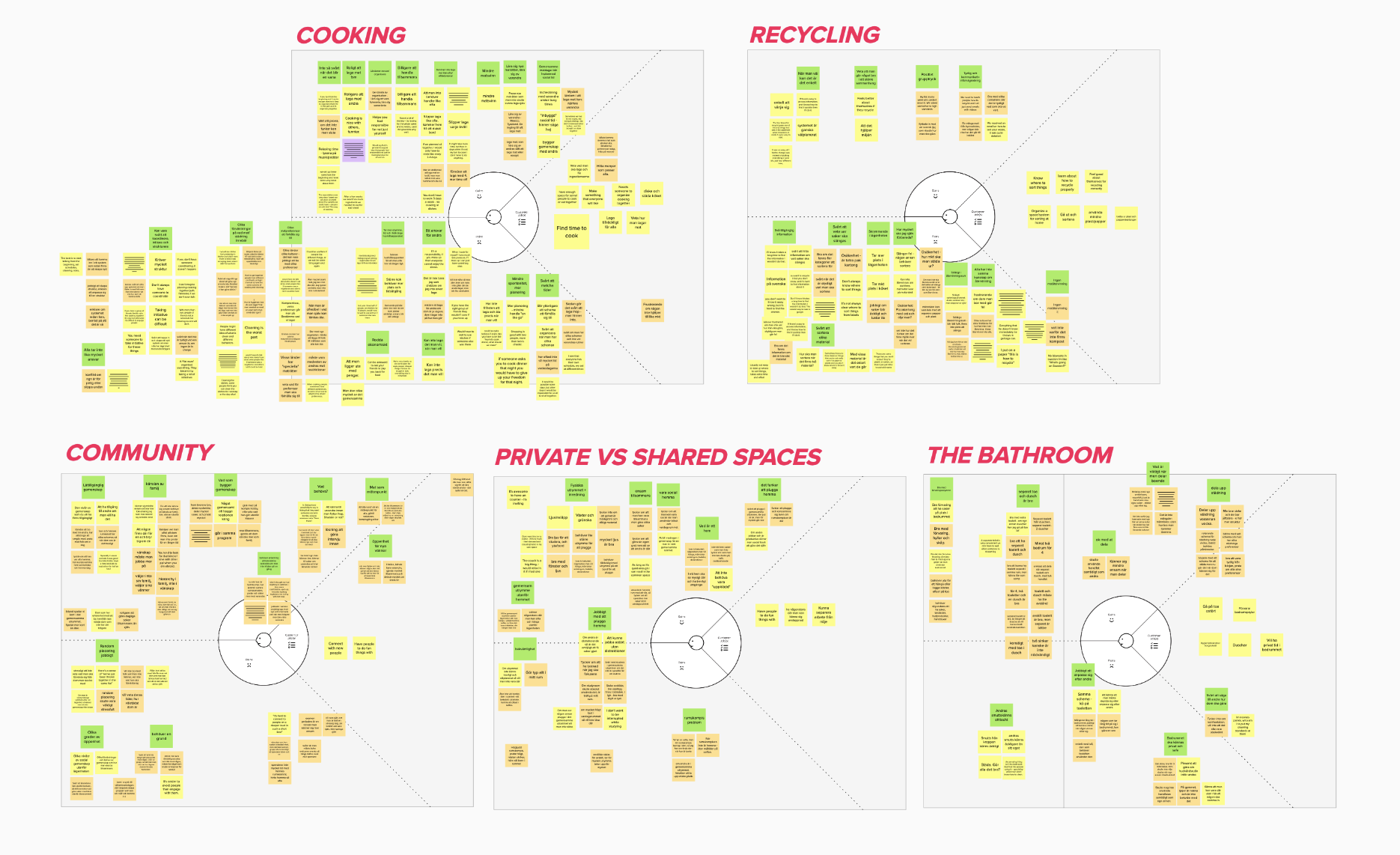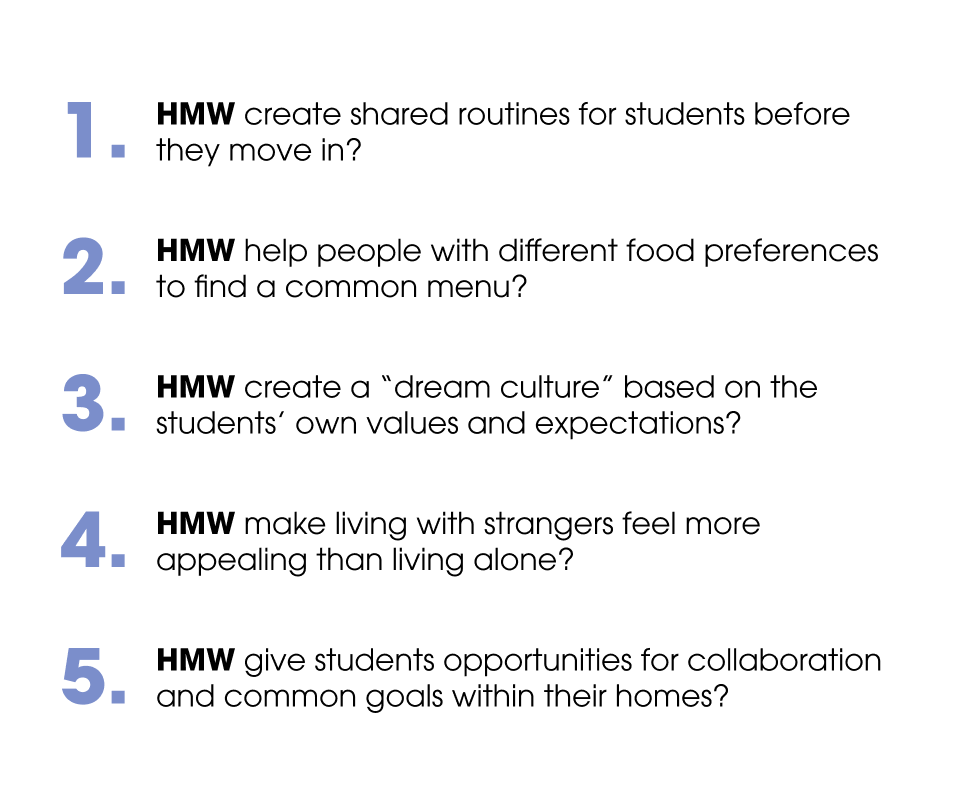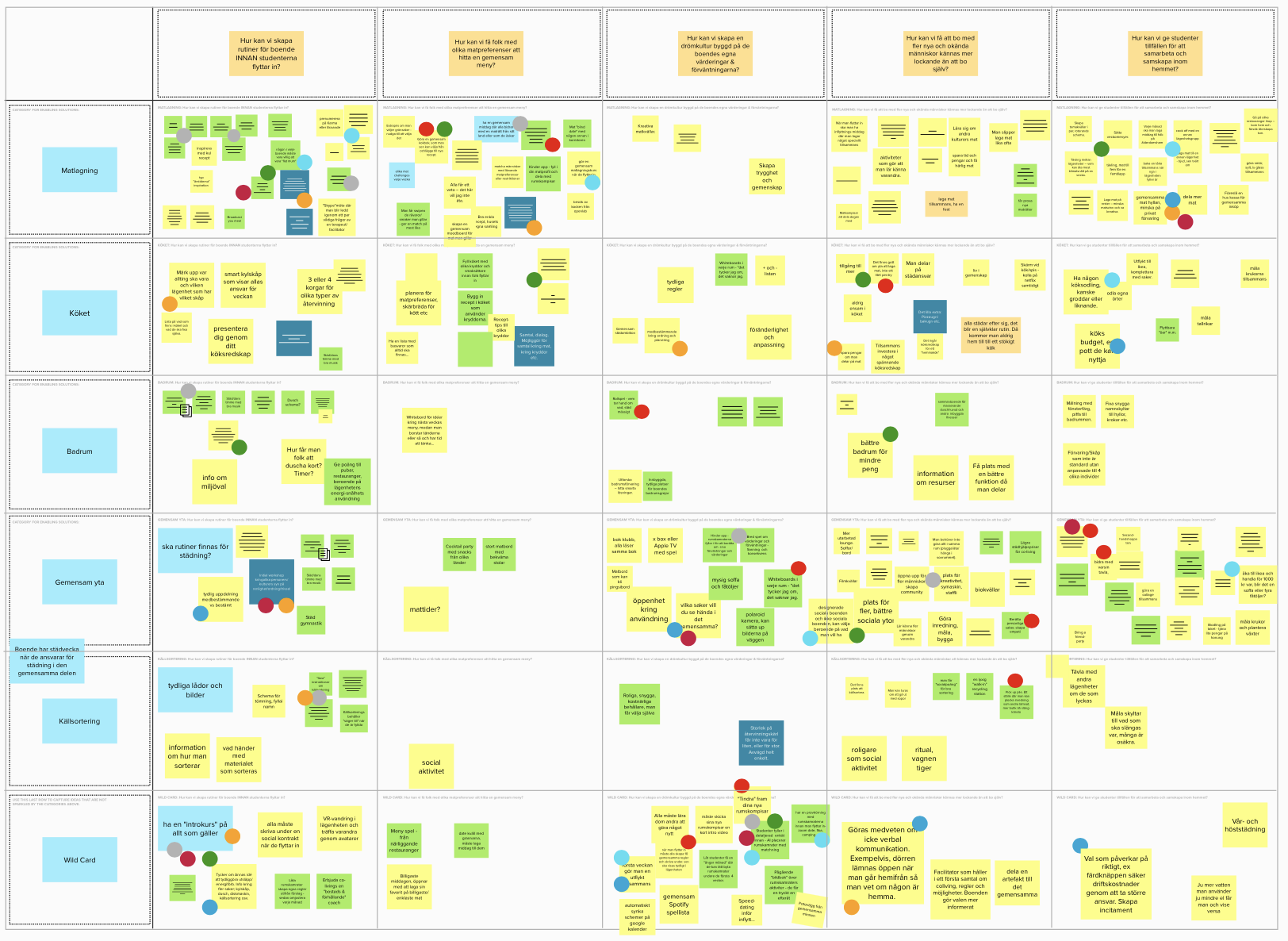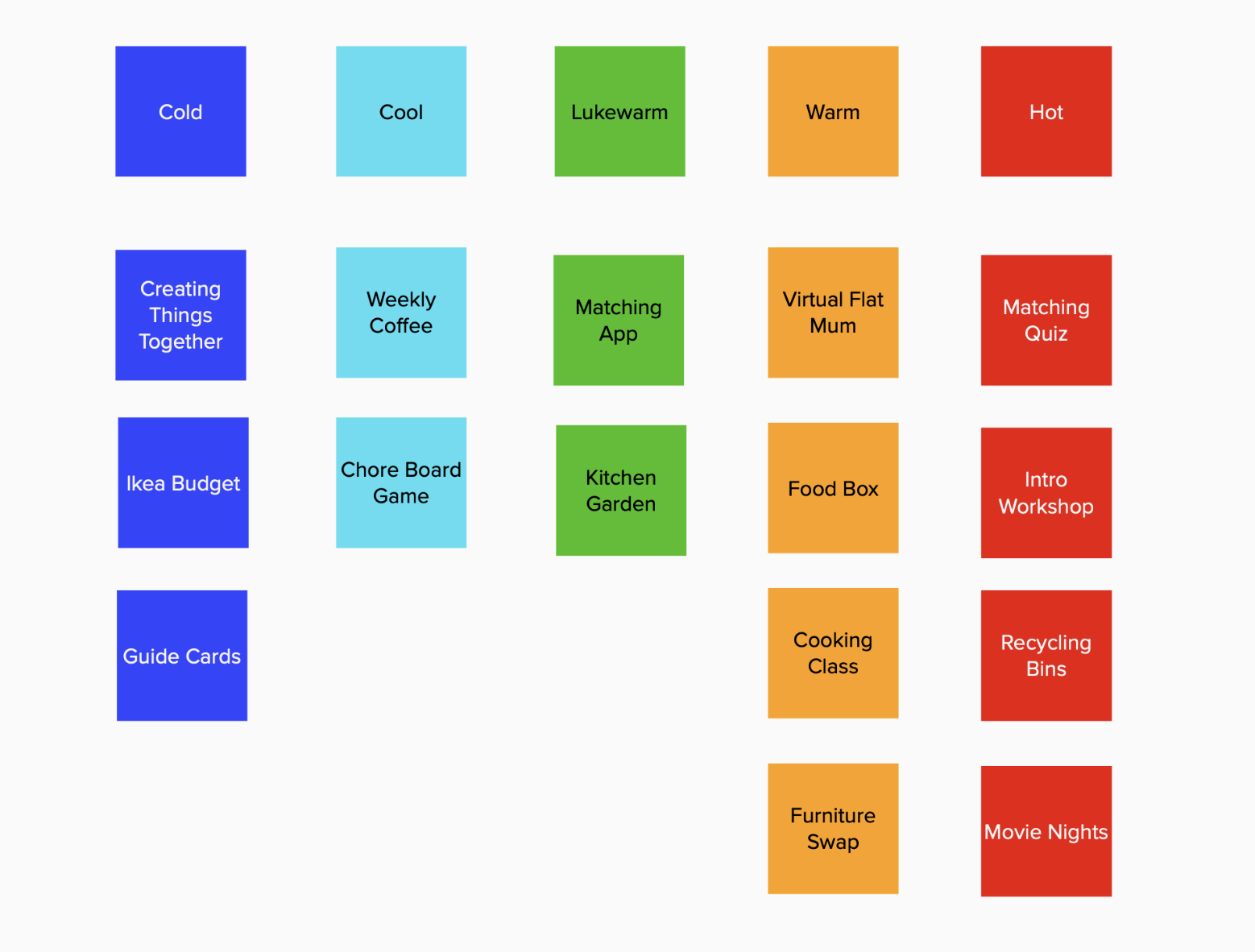KTH Co -Kitchen
Reimagining student housing in Sweden to be more sustainable and collaborative.
I designed and prototyped a series of service recommendations for the Swedish government to promote sustainability and community in student apartments.
Currently, many university students in Sweden live alone in one-room flats, with their own bathroom and kitchen. Loneliness is prevalent among young people and these flats use unnecessary amounts of resources and energy. This initiative, which was a collaboration between Savvy Design Collaborative, KTH, Akademiska Hus, and TIP Architects, sought to create a new norm of co-living for students, with a focus on the kitchen and other shared spaces that support a sustainable lifestyle. As a Service Designer and Design Research Lead on the project, I sought to understand current student needs and pain points in relation to housing and sustainability. My research findings and solution recommendations are being used to inform the design and implementation of 5,000 - 10,000 new student homes being built in Sweden.
Read the official brief on the project here.
Opportunity
Students provide a unique opportunity to establish sustainable habits and implement new social solutions.
There is currently a shortage of student housing in several cities in Sweden. In 2014, Akademiska Hus, a Swedish Government enterprise, was given an expanded mission to develop, build, and manage 10,000 new long-term student homes that are both sustainable and community-based.
Along with this need for increased student housing, students also are a prime group to enact change. Generally, students are a group already prone to change and flexibility, and are more open to environmental issues and new ways of living.
Project Goals
Promote the kitchen as a communal space.
The kitchen is a central place for energy use in the home. It creates opportunities for community but also friction and conflicts to arise.
Encourage roommates to cook together.
Cooking together is an opportunity for bonding and decreases food waste.
Encourage students to eat plant-based foods.
Plant based diets are better for the environment and are linked to lower greenhouse-gas emissions.
Simplify the experience of recycling.
Sweden has a highly sorted recycling system that can be difficult for non-natives.
Encourage social bonds and shared positive behaviors.
Roommate bonding leads to more positive living experiences and increases the likelihood of shared behaviors.
Solutions
Process
Research
I conducted two rounds of user interviews. The initial interviews sought to understand how University students in Sweden currently live and identify pain points and needs; the second round of interviews sought to dig deeper into our findings and test certain hypotheses. I interviewed 23 students at KTH of 12 different nationalities.
Initial Interviews
In our first round of interviews, I spoke with 12 students to broadly understand their current habits, pain points, and needs concerning cooking, sustainability, community, and co-habitation. Our goals was to paint an initial picture of student life and gain insight into areas of opportunity.
First, we extracted overall positive and negative observations regarding student living.
Initial Insights
From these initial interviews we synthesized a few key insights.
Second Round Interviews
From the initial interviews, my co-designer and I crafted a new interview guide to dive deeper into specific areas of interest. I conducted interviews with 11 additional KTH students.
Our questions specifically sought to understand how students experience cooking with others, recycling, community, and shared spaces. Some of the questions we asked include:
I also created an interactive portion of the interview using a Mural board.
The first section asked participants to indicate the activities they do in the different spaces in their apartment. The goal of this was to visualize what students do in the home and how they use the physical space.
The next section asked interviewees to react to images of different common spaces and bathrooms to understand what students look for and dislike about different layouts.
Define
Customer Value Proposition Canvases
From the second round interviews, I synthesized what I heard about cooking, recycling, community, shared spaces, and bathrooms into separate value proposition canvases to better extract the current student pains, gains, and objectives in each of these realms.
Insights
Insight #1:
Observations:
Occasions where you can collaborate in an unforced way create common experiences that facilitate relationships, and the closer you become the more it affects all aspects of interaction in co-living.
Just because people live together, it is not guaranteed that they will find a community at home which they want to spend time in or work on.
It is more difficult and takes longer to get to know each other as a group if you have no obvious common denominators to gather around or openness to get to know each other.
User quotes:
Insight #2:
Observations:
Student accommodations are usually temporary and during this limited time it can feel superfluous to put energy into creating common structures.
When it comes to joint cooking, it is not the details (cooking, buying, eating together) that are experienced as difficult, but rather the initiative to put it all together.
The same applies to cleaning and waste sorting - the act itself is not perceived as difficult, but creating rules and structures feels sensitive and risks personal conflict.
User quotes:
Insight #3:
Observations:
Sacrificing any time can sometimes feels impractical and unfeasible.
The compulsion to eat "someone else's food" feels like a sacrifice if you have to do it regularly.
Eating with others from time to time is experienced more as a social advantage than as being about the cooking itself.
The perceived disadvantages of sacrificing time for joint cooking does not match the actual experience and positive effects of cooking together regularly. Cooking jointly every third/fourth day actually saves time.
User quotes:
Insight #4:
Observations:
Having different expectations regarding social presence can lead to feeling like a stranger in your own home and not being able to be yourself. If you feel uncomfortable, you retreat from the common spaces to your safe and private sphere.
If you have things that are important to you and you cannot make sure that your future roommates can live up to this, it may mean that you opt out of living with people before you have given it a chance.
Different experiences of standards around cleanliness, use of bathrooms and common areas can create feelings of discomfort.
User quotes:
How Might We Questions
From these insights, we crafted a series of How Might We questions and held a co-creation workshop with our clients and partners to narrow down our top five.
Ideate
Brainstorming
I facilitated a brainstorming workshop with representatives from KTH, TIPP and Akademiska Hus. Based on our HMW questions, I made a creative matrix with the HMW questions on one axis and the different aspects of co-living (cooking, the kitchen, the bathroom, shared spaces, and recycling) on the other. Together with our clients, we generated over 200 ideas which we then refined by dot-voting on our favorites.
It was at this point in the project that I took over as design lead to move forward with ideation, prototyping, and testing.
Prototyping
Using the top ideas from our brainstorming session and our insights, I fleshed out 15 different solutions to prototype.
The solutions fell into seven different areas of opportunity: roommate matching, intro workshops, creating routines, communal cooking, recycling, furnishing, and creating community. I created several iterations of visual prototypes for each idea using Figma and photoshop.
While I prototyped 15 separate ideas, I’ll use two of the ideas, aimed at establishing shared routines, as an example of the process.
Creating Routines
We found that it was easier for students to adapt to existing routines than it was to create new ones, so I aimed to design a way to reduce the burden of creating a chore system for students, while still allowing for ownership over their routines.
The two solutions with the highest amount of votes from our ideation session were a chore-allocator app would allow students to input household chores that need to be done and automatically assign people to them each week. A chore boardgame would create a fun and low-pressure way to allocate chores.
Testing
I tested the solutions through 8 user interviews and AB testing over Zoom. Due to COVID constraints, I was unable to hold any in-person experiential prototyping sessions.
Findings
Chore-allocator app
Students overall found this solution to be easy to use and that it would alleviate a lot of the current issues they experience with allocating chores. The main feedback I received was (1) that it must allow for flexibility regarding timing and which chores are being assigned, (2) it should be able to integrate into existing calendar or scheduling apps that people already use, and (3) that allocating cooking schedules should be separate from other chores.
“It’s good because it's not your roommate telling you hey you should clean the bathroom”
“I think this is really helpful and useful for people to see what they have to do each week”
“It needs to be flexible so that it fits our availabilities and preferences”
Chore board game
While students found this to be a fun way to split up chores, in practice, it would likely not be very effective. Students felt it would take too much time and that they would probably not use it more than once or twice.
“I really appreciate it because it may maybe kind of forces people that aren't so social to be a little bit more like engaged"
“It makes an easy decision into too much”
Define
Prioritization
From my research findings, I gave each idea a rating based on how students reacted to them and how well they addressed the needs we found.
After presenting my prototypes and findings to the clients, we jointly arranged the solutions in a Priority Matrix to determine which would be worthwhile pursuing further.W e took into account solution impact, effort, feasibility, and how well it addresses the needs and problems we found.
Based on our priority matrix, we decided to focus on solutions primarily in the high impact, low effort quadrant, as well as a few in the high impact, high effort quadrant.
The solutions we decided to further develop were, as described in detail in the above solution section, the roommate matching quiz, intro workshop, chore allocator app, food subscription box, color-coded recycling bins, furniture swap room, and movie nights.
Current State of the Project
I left the project in the winter of 2021 to return to school, handing off my findings to those in charge of the project at KTH. Based off my ideas and suggestions, the above solutions are being developed and prototyped by the KTH researchers in existing student housing to later be implemented in the new accommodations.
